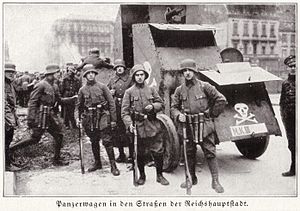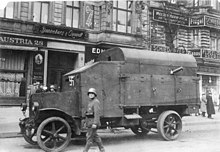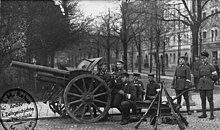Freikorps
Armed Freikorps paramilitaries in Berlin in 1919.
In the aftermath of World War I and during the German Revolution of 1918–19, Freikorps consisting largely of World War I veterans were raised as right-wing paramilitary militias, ostensibly to fight on behalf of the government[1] against the Soviet-backed German Communists attempting to overthrow the Weimar Republic.[2][3] However, the Freikorps also largely despised the Republic and were involved in assassinations of its supporters.[4][5]
Contents
Origins
Serbian, Wurmser, Odonel and Mahony Free Corps in 1798
These early Freikorps appeared during the War of the Austrian Succession and especially the Seven Years' War, when France, Prussia and the Habsburg Monarchy embarked on an escalation of petty warfare while conserving their regular regiments. Even during the last Kabinettskrieg, the War of the Bavarian Succession, Freikorp formations were formed in 1778. Germans, Hungarians, Poles, Lithuanians and South Slavs, as well as Turks, Tatars and Cossacks, were believed by all warring parties to be inherently good fighters. The nationality of many soldiers can no longer be ascertained as the ethnic origin was often described imprecisely in the regimental lists. Slavs (Croats, Serbs) were often referred to as "Hungarians" or just "Croats", and Muslim recruits (Albanians, Bosnians, Tatars) as "Turks".
For Prussia, the Pandurs, who were made up of Croats and Serbs, were a clear model for the organization of such "free" troops. Frederick the Great created 14 "free infantry" (Frei-Infanterie) units, mainly between 1756 and 1758, which were intended to be attractive to those soldiers who wanted military "adventure", but did not want to have to do military drill. A distinction should be made between the Freikorps formed up to 1759 for the final years of the war, which operated independently and disrupted the enemy with surprise attacks and the free infantry which consisted of various military branches (such as infantry, hussars, dragoons, jäger) and were used in combination. They were often used to ward off Maria Theresa's Pandurs. In the era of linear tactics, light troops had been seen necessary for outpost, reinforcement and reconnaissance duties. During the war, eight such volunteer corps were set up:
- Trümbach's Freikorps (Voluntaires de Prusse) (FI)
- Kleist's Freikorps (FII)
- Glasenapp's Free Dragoons (F III)
- Schony's Freikorps (F IV)
- Gschray's Freikorps (F V)
- Bauer's Free Hussars (F VI)
- Légion Britannique (FV - of the Electorate of Brunswick-Lüneburg)
- Volontaires Auxiliaires (F VI).[6]
In France, many corps continued to exist until 1776. They were attached to regular dragoon regiments as jäger squadrons. During the Napoleonic Wars, Austria recruited various Freikorps of Slavic origin. The Slavonic Wurmser Freikorps fought in Alsace. The combat effectiveness of the six Viennese Freikorps (37,000 infantrymen and cavalrymen), however, was low. An exception were the border regiments of Croats and Serbs who served permanently on the Austro-Ottoman border.
Napoleonic era
Painting of three famous Free Corps members in 1815: Heinrich Hartmann, Theodor Körner, and Friedrich Friesen
The Freikorps attracted many nationally disposed citizens and students. Freikorps commanders such as Ferdinand von Schill, Ludwig Adolf Wilhelm von Lützow or Frederick William, Duke of Brunswick-Wolfenbüttel, known as the "Black Duke", led their own attacks on Napoleonic occupation forces in Germany. Those led by Schill were decimated in the Battle of Stralsund (1809); many were killed in battle or executed at Napoleon's command in the aftermath. The Freikorps were very popular during the period of the German War of Liberation (1813–15), during which von Lützow, a survivor of Schill's Freikorps, formed his Lützow Free Corps. The anti-Napoleonic Freikorps often operated behind French lines as a kind of commando or guerrilla force.
Throughout the 19th century, these anti-Napoleonic Freikorps were greatly praised and glorified by German nationalists, and a heroic myth built up around their exploits. This myth was invoked, in considerably different circumstances, in the aftermath of Germany's defeat in World War I.
1815–1871
Even in the aftermath of the Napoleonic era, Freikorps were set up with varying degrees of success.During the March 1848 riots, student Freikorps were set up in Munich.
In First Schleswig War of 1848 the Freikorps of von der Tann, Zastrow and others distinguished themselves.
In 1864 in Mexico, the French formed the so-called Contreguerrillas under former Prussian hussar officer, Milson. In Italy, Garibaldi formed his famous Freischars, notably the "Thousand of Marsala", which landed in Sicily in 1860.
Even before the Franco-Prussian War of 1870/71, Freikorps were developed in France that were known as franc-tireurs.
Post–World War I
Minister of the Reichswehr, Gustav Noske, visits the Freikorps Hülsen in Berlin in January 1919.
On 5 May 1919, members of Freikorps Lützow in Perlach near Munich, acted on a tip from a local cleric and arrested and killed twelve alleged communist workers (most of them actually members of the Social Democratic Party). A memorial on Pfanzeltplatz in Munich today commemorates the incident.[8][9][10]
Provisional Freikorps armored vehicle in Berlin during the Kapp Putsch of March 1920.
A recruitment poster for the Freikorps Hülsen.
Hitler eventually viewed some of them as threats. A huge ceremony was arranged on 9 November 1933 in which the Freikorps leaders symbolically presented their old battle flags to Hitler's SA and SS. It was a sign of allegiance to their new authority, the Nazi state.[16] When Hitler's internal purge of the party, the Night of the Long Knives, came in 1934, a large number of Freikorps leaders were targeted for killing or arrest, including Ehrhardt and Röhm. Historian Robert GL Waite claims that in Hitler's "Röhm Purge" speech to the Reichstag on 13 July 1934, he implied that the Freikorps were one of the groups of "pathological enemies of the state".[17]
Freikorps units
Freikorps howitzer in 1919.
Freikorps soldiers pictured during the Kapp Putsch of March 1920.
Freikorps Lützow in Zossen in 1920.
Sudeten German Freikorps in Czechoslovakia, 1938.
- Iron Division (Eiserne Division, related to Eiserne Brigade and Baltische Landeswehr)
- Fought in the Baltic.
- Defeated by the Estonian Army in the Battle of Cēsis[18]
- Trapped in Thorensberg by the Latvian Army. Rescued by the Rossbach Freikorps.[19]
- Volunteer Division of Horse Guards (Garde-Kavallerie-Schützendivision)
- Killed Rosa Luxemburg and Karl Liebknecht, 15 January 1919[20]
- Led by Captain Waldemar Pabst[20]
- Disbanded on order of Defence Minister Gustav Noske, 7 July 1919, after Pabst threatened to kill him[21]
- Freikorps Caspari
- Fought against the Bremen Soviet Republic
- Fought under the command of Walter Caspari
- Freikorps Lichtschlag
- Fought against the Red Ruhr Army
- Fought under the command of Oskar von Watter
- Freikorps Epp
- Under the command of Franz Ritter von Epp[22]
- Members include: Ernst Röhm,[22] Rudolf Hess,[23] Eduard Dietl,[24] Hans Frank,[25] Gregor Strasser and Otto Strasser.[26]
- Freikorps Lützow
- Occupied Munich following the revolution of April 1919.
- Commanded by Major Schulz[27]
- Marinebrigade Ehrhardt (The Second Naval Brigade)
- Participated in the Kapp Putsch of 1920[28]
- Disbanded members eventually formed the Organisation Consul, which performed hundreds of political assassinations[29]
- Marinebrigade Loewenfeld (The Third Naval Brigade)[30]
- Participated in the Kapp Putsch of 1920
- Freikorps Maercker (Maercker's Volunteer Rifles, or Freiwilliges Landesjägerkorps)[31]
- Had Reinhard Heydrich as a member[32][33]
- Founded by Ludwig Maercker
- Freikorps Oberland
- Kurt Benson
- Freikorps Roßbach (Rossbach)
- Founded by Gerhard Roßbach
- Rescued the Iron Division after an extremely long march across Eastern Europe.[19]
- had Rudolph Hoess as a member.
- Sudetendeutsches Freikorps
- Formed by Czech German nationalists with Nazi sympathies which operated from 1938 to 1939
- Part of Hitler's successful effort to absorb Czechoslovakia into the Third Reich
World War II
In French, the Freikorps are referred to as "Corps Franc." Starting in October 1939, the French Army stood up a number of Corps Franc units with the mission of carrying out ambush, raid, and harassing operations forward of the Maginot Line during the period known as The Phoney War (Drôle de Guerre). They were tasked with attacking German troops guarding the Siegfried Line. Future Vichy collaborationist, Anti-Bolshevik and SS Major Joseph Darnand was one of the more famous participants in these commando actions.In May of 1940, the experience of the Phoney War era Corps Franc was an influence in creating the Groupes Francs Motorisé de Cavalerie (GFC) who played storied role in the delaying operations and last stands of the Battle of France, notably in the defenses of the Seine and the Loire.
On November 25 1942, in the immediate aftermath of the Allied Invasion of Vichy French North Africa the Corps Francs d'Afrique (CFA)(African Corps Franc) was stood up in French Morocco within the Free French Forces by General Giraud. Giraud drew the members of the all-volunteer unit from Moroccans of diverse religious backgrounds (Christian, Jew, and Muslim) and gave them the title of Vélite a name inspired by the elite light infantry of Napoleon's Imperial Guard who were named after the Roman Velites. Much of the Corps was drawn from Henri d'Astier de la Vigerie and José Aboulker's Géo Gras French Resistance Group which had been responsible for the Algiers Insurrection where the Resistance seized control of Algiers on the night of November 8 1942 in coordination with the Allied landings happening that same night. In taking over Algiers, they managed to capture both Admiral Darlan and General Juin which led to the Darlan Deal wherein Vichy French forces came over to the Allied side. Darlan was later assassinated by Fernand Bonnier de La Chapelle an early member of the Corps Franc d'Afrique. They functioned as the Free French equivalent to the British Commandos. The Corps Francs d'Afrique went on to fight Rommel's Afrikakorps in Tunisia with the U.S. 5th Army. They fought alongside the British 139th Brigade at Kassarine and Sidi Nasr where they famously conducted a heroic bayonet charge, facing two to one odds, against the Italian 34th Battalion of the 10th Bersaglieri near the mountain of Kef Zilia on the road to Bizerte, taking 380 prisoners, killing the Italian Battalion Commander, and capturing the plans for Operation Auslading. They participated in the capture of Bizerte in May 1943.
For its actions, the Corps Franc d'Afrique was awarded the Croix de Guerre.
The CFA was formally dissolved on July 9 1943, with its members and equipment forming the corps of the newly created African Commando Group (GCA) on July 13 1943 in Dupleix, Algeria, today seen as a forbear to the post war Parachutist Shock Battalions and the modern day 13th RDP. The GCA went on to fight at Pianosa, Elba, Salerno, Provence, Belfort, Giromagny, Alsace, Cernay, Guebwiller, Buhl, and the Invasion of Germany.
See also
- Freikorps Awards
- List of defunct Paramilitary Organizations
- List of Free Corps
- List of Freikorps members
- List of Paramilitary Organizations
- Organisation Consul
- Freikorps in the Baltic
- Battle of Annaberg
- Free Corps Denmark
- Viking League related Freikorps activities
- Free company Medieval units with some similarities
References
NotesSee also the full text of the speech at http://members.tripod.com/~Comicism/340713.html
Waite, p. 38 was invoked but never defined (see the help page).
- Mueller, p 61
- Blanke, Richard (1993). Orphans of Versailles: The Germans in Western Poland, 1918–1939. University Press of Kentucky. ISBN 0-8131-1803-4.
- Childers, Thomas (2017). The Third Reich: A History of Nazi Germany. New York: Simon & Schuster. ISBN 978-1-45165-113-3.
- Davidson, Eugene (2004). The unmaking of Adolf Hitler. University of Missouri Press.
- Geiss, Immanuel; Jacobmeyer, Wolfgang, eds. (1980). Deutsche Politik in Polen 1939-1945. Aus dem Diensttagebuch von Hans Frank, Generalgouverneur in Polen (in German). Opladen: Leske + Budrich. ISBN 978-3810002969.
- Eley, Geoff (1990). "Conservatives and radical nationalists in Germany: the production of fascist potentials, 1912–28". In Blinkhorn, Martin (ed.). Fascists and Conservatives: The Radical Right and the Establishment in Twentieth-Century Europe. New York, NY: Routledge. pp. 50–70. ISBN 978-0-049-40087-0.
- Gerwarth, Robert (2008). "The Central European Counter-Revolution: Paramilitary Violence in Germany, Austria and Hungary after the Great War". Past & Present. 200 (1): 175–209. doi:10.1093/pastj/gtm046.
- Hoess, Rudolf; Fitzgibbon, Constantine; Levi, Primo (2000). Commandant of Auschwitz: The Autobiography of Rudolf Hoess. Translated by Constantine Fitzgibbon, Joachim Neugroschel. Sterling Publishing. ISBN 1-84212-024-7.
- Hürter, Johannes (2007). Hitlers Heerführer. Die deutschen Oberbefehlshaber im Krieg gegen die Sowjetunion 1941/42. 2nd edition (in German). Oldenbourg, Munich. ISBN 978-3-486-58341-0.
- Koepp, Roy G. (2010). Conservative Radicals: The Einwohnerwehr, Bund Bayern Und Reich, and the Limits of Paramilitary Politics in Bavaria, 1918–1928 (PhD). Lincoln, NE: University of Nebraska.
- Kolko, Gabriel (1994). Century of War: Politics, Conflicts, and Society since 1914. New York, NY: The New Press. ISBN 978-1-565-84192-5.
- Morris, Douglas G. (2005). Justice Imperiled: The Anti-Nazi Lawyer Max Hirschberg in Weimar Germany. University of Michigan Press. ISBN 0-472-11476-X.
- Mueller, Michael (2007). Canaris. Naval Institute Press.
- Padfield, Peter (2001). Hess: The Fuhrer's Disciple. London: Cassell & Co. ISBN 0-304-35843-6.
- Read, Anthony (2004). The Devil's Disciples: Hitler's Inner Circle. W. W. Norton & Company. ISBN 0-393-04800-4.
- Waite, Robert G. L. (1969) [1952]. Vanguard of Nazism: The Free Corps Movement in Post-War Germany, 1918–1923. New York, NY: W. W. Norton & Company. OCLC 3633548.










